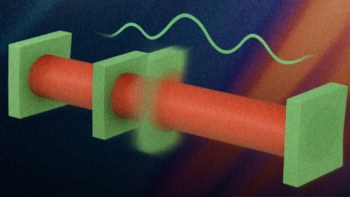
An ultracompact beamsplitter – the smallest one in the world – has been designed and fabricated by researchers in the US. Using a newly developed algorithm, the team built the smallest integrated polarization beamsplitter to date, which could allow computers and mobile devices of the future to function millions of times faster than current machines.
Beamsplitters divide light waves into two separate channels of information, and will be crucial for the development of so-called silicon photonic chips that compute and shuttle data using light instead of electrons. “Light is the fastest thing you can use to transmit information,” says Rajesh Menon, an electrical and computer engineer at the University of Utah. “But that information has to be converted to electrons when it comes into your laptop. In that conversion, you’re slowing things down. The vision is to do everything in light.”
Light maze
Silicon photonics could significantly increase the power and speed of machines such as supercomputers and data-centre servers. In theory, devices employing such chips should not only be faster, but also consume far less power as well. Measuring only 2.4 × 2.4 μm2, the new beamsplitter is nearly 50 times smaller than any beamsplitter created to date. It also has an unorthodox maze-like shape. “Most polarizing beamsplitters do not look like this today,” says Menon. “We wanted our device to be as easy as possible to fabricate using existing techniques, and to be as efficient as possible.”
To do this, Menon and his team created an algorithm that tried various geometries, until it found the smallest and most efficient design. Menon described this process as a “smart” search, explaining that “the ‘smartness’ is important because there are too many possibilities to try and the alternatives would take a very long time.” As the design takes existing manufacturing techniques into account, the team says its beamsplitter could be produced on an industrial scale almost as inexpensively as electronic transistors are today.
Tech library
Menon noted, however, that many other technological advances will be needed before a fully photonic computer is possible. “For our device to be utilized fully, we need a whole library of other complementary devices, all of which are highly miniaturized and efficient. These devices will enable different functions such as bending the light, splitting the light, transporting light, modulating the light, and so on,” Menon says. “Once such a library is available to designers, one can expect them to put such devices together into functional circuits. That’s when the most fun and unexpected results will come.”
Andrea Alù, a researcher at the University of Texas, Austin, who did not participate in the research, thinks the team’s algorithm could have other uses as well. Last year, Alù and his collaborators proposed the idea of designing artificial materials that can perform mathematical operations as light propagates through them. “I believe the concept pushed forward by Menon and his colleagues is not limited to polarization control,” says Alù. He told physicsworld.com that it may also be “a viable platform to imprint mathematical operations of choice on a CMOS compatible chip” – a widely used type of semiconductor.
Zongfu Yu, an electrical and computer engineer at the University of Wisconsin-Madison who was also not involved in the study, called the new beamsplitter design a significant advance in silicon photonics. He adds that the work shows, for the first time, that “computational optimization can be used to achieve ultra-compact devices that are absolutely beyond the intuition of even the most experienced device designer”.
The research is published in Nature Photonics.



